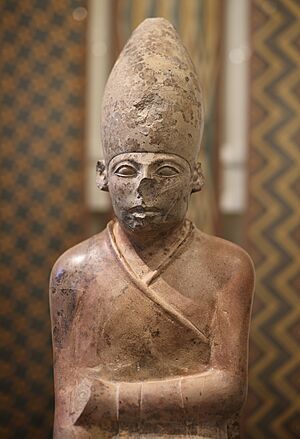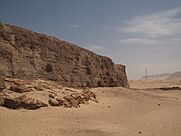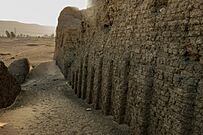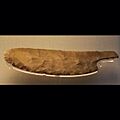Khasekhemwy facts for kids
Quick facts for kids Khasekhemwy |
|
|---|---|
| Khasekhemui, Cheneres | |

Statue of Khasekhemwy, Ashmolean Museum
|
|
| Pharaoh | |
| Reign | 18 years ca. 2690 BC (2nd Dynasty) |
| Predecessor | Sekhemib-Perenmaat or Seth-Peribsen |
| Successor | Djoser |
| Consort | Nimaathap, Menka (?) |
| Children | Djoser Hetephernebti Sekhemkhet ? Sanakht ? Shepset-ipet ? |
| Died | 2686 BC |
| Burial | Tomb V at Umm el-Qa'ab |
| Monuments | Shunet ez Zebib, fort of Nekhen, Gisr el-Mudir ? |
Khasekhemwy (pronounced Kha-sek-hem-wee) was an important ancient Egyptian king, known as a Pharaoh. He was the last ruler of Egypt's Second Dynasty, around 2690 BC. Not much is known about his life, but he led several important military campaigns. He also built a large mudbrick fort called Shunet El Zebib.
His Horus name, Ḫꜥj-sḫm.wj, means "The Two Powerful Ones Appear". This name likely refers to the two main gods, Horus and Set.
Contents
How Long Did Khasekhemwy Rule?
Khasekhemwy ruled for about 18 years. His reign was in the early 27th century BC, roughly between 2690 and 2670 BC. Historians use ancient records like the Palermo Stone to estimate how long pharaohs ruled. This stone suggests Khasekhemwy ruled for nearly 18 full years.
Khasekhemwy's Life and Legacy
Khasekhemwy is usually thought to have taken over after Seth-Peribsen. However, some historians believe another pharaoh, Khasekhem, ruled in between them. Most scholars now think Khasekhem and Khasekhemwy were actually the same person.
It's believed that Khasekhem changed his name to Khasekhemwy. This might have happened after he reunited Upper and Lower Egypt. These two parts of Egypt had been fighting in a civil war. The conflict was between followers of the gods Horus and Set. Other theories suggest he defeated King Seth-Peribsen after stopping a revolt in Nubia. Either way, he brought an end to the fighting and reunited Egypt.
Khasekhemwy is special in Egyptian history. He was the only king to have symbols of both Horus and Set on his serekh. A serekh is a special symbol used to show a pharaoh's name. Some Egyptologists think this was his way of trying to bring the two groups together. After he died, the symbol of Set was no longer used on the serekh. He was also the first Egyptian king known to have built statues of himself.
After reuniting Egypt, Khasekhemwy started many big building projects. He built structures using stone in places like el-Kab, Hierakonpolis, and Abydos.
He also built a very large and unique tomb in Abydos. This was the last royal tomb built in that area. The tomb is shaped like a trapezoid, about 70 meters (230 feet) long. It is 17 meters (56 feet) wide at one end and 10 meters (33 feet) wide at the other. Inside, there were 58 rooms. Its main burial room was once thought to be the oldest stone structure in the world.
In his tomb, archaeologists found many interesting items. These included the king's scepter made of gold and carnelian. They also found beautiful small stone pots with gold leaf lids. Other items were flint tools, copper tools, and pottery filled with grain and fruit. Small glazed objects, beads, and many seals were also discovered.
Khasekhemwy also built large enclosures at Nekhen and Abydos. The one at Abydos is now known as Shunet ez Zebib. He was buried in his tomb at Umm el-Qa'ab. It's also possible he built the Gisr el-Mudir at Saqqara.
One ancient writing on a stone vase mentions him "fighting the northern enemy within Nekheb". This might mean that forces from Lower Egypt tried to attack or take over Nekhen, which was the capital of Upper Egypt.
Khasekhemwy's Family
Khasekhemwy's wife was Queen Nimaathap. She was known as the "King bearing mother." They were the parents of Djoser and Djoser's wife, Hetephernebti. It is also possible that Khasekhemwy had other sons, Sekhemkhet and Sanakhte. These two kings ruled after Djoser.
Images for kids
-
Statue of Khasekhemwy, Ashmolean Museum
-
Statue of Khasekhemwy, Egyptian Museum, Cairo
-
Khasekhemwy in the Ashmolean Museum






![Khasekhemwy's tomb at [[Umm el-Qa'ab]] filled with sand](/images/thumb/f/f0/Khasekhemwy%27s_Tomb.jpg/120px-Khasekhemwy%27s_Tomb.jpg)




